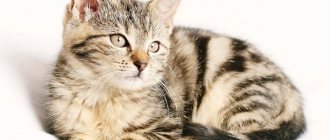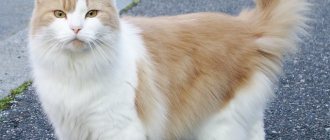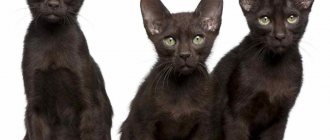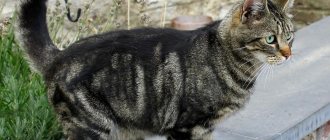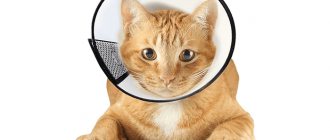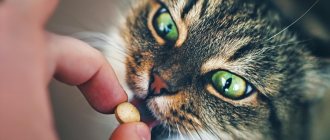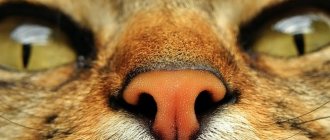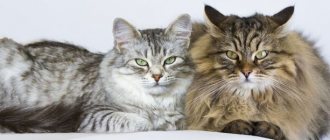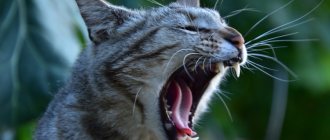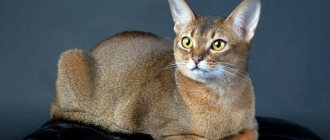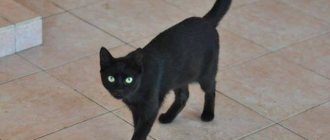Congenital tail defects
We are talking about a structural feature of the tail, which occurs quite often in newborn kittens. According to statistics, some cat breeds are especially susceptible to congenital tail defects (for example, Burmese or Scottish fold cats).
In itself, such a hall is not scary and does not in any way threaten the life or health of the pet. You just have to remember that if a cat has a broken tail, the path to exhibitions and competitions among its own kind will be closed. Such an individual is considered to be out of condition, that is, not suitable in terms of body structure parameters. So an animal with a congenital crease will delight the eye and heart exclusively at home. You will have to forget about the career of a “cat model”.
Another important factor is the ability of cats to pass on the peculiarity of their tail structure by inheritance. In other words, future kittens have every chance of repeating the fate of the “crooked-tailed” parent. Moreover, this anomaly may worsen, and the offspring may develop complications in the form of spinal disorders, coordination of movements and many other troubles. This is why an animal with a crooked tail is not suitable for breeding. The best way out of the situation would be castration or sterilization.
Structure and shape of the tail
The cat's tail is an extension of the spine and, depending on the breed, can grow up to 40-50 cm and have up to 27 vertebrae. It is divided into 3 main parts:
- Root. It starts right from the sacrum and includes 4-6 wide fused vertebrae.
- Stem. It consists of 10-15 elongated vertebrae, between which there are connective cartilages. The voids around the cartilage are filled with jelly-like intervertebral fluid. Thanks to this structure, the cat's tail is flexible and can take on different shapes.
- Tip. It consists of short and thin vertebrae, on one side of the last of which there is no connecting cartilage and articular surface.
Due to the high mobility of the ligaments and tendons that make up the cat's tail, it can curl into a variety of shapes without causing damage to the animal.
Fracture as a result of injury
Often a crease in the tail appears as a result of injury..
Blows, bites, falls from a height, a tail pinched by a door - this is not a complete list of reasons for a cat's tail to be bent. Unfortunately, the owner does not always pay due attention to this fact, and even less often a splint, plaster, or at least a pressure bandage is applied to the damaged area. The cat continues to live with a damaged tail. The injury heals slowly and poorly, resulting in an improperly healed injury. This is what provokes the appearance of a crease.
Head injuries or diseases of the nervous system suffered by the cat are considered even more dangerous. In such cases, pinching of the bundle of nerves in the caudal region and damage to the spinal cord may occur. In such cases, the pet's tail may take on an atypical shape.
Sometimes, after an injury, a crease in the tail appears and at the same time, the animal exhibits strangeness in its gait. If a crooked tail is accompanied by disturbances in motor activity or the cat begins to have difficulty oriented in space, this is a serious reason to contact a veterinarian.
Genetics of the Kurilian Bobtail tail
One of the rarest features of such an interesting breed as the Kuril Bobtail is, of course, its unique tail.
Kurilian bobtail cat
Since the Kurilian Bobtail is one of the fairly young breeds, talking about the genetics of the Kurilian short tail will not be easy. The fact is that almost no one has carried out control crosses of Kurilian bobtails with ordinary tailed cats or bobtails of other breeds. The prevailing opinion was that the Kuril tail mutation is dominant and has a polygenic inheritance pattern. Unplanned, rare crossings of Kurils with representatives of long-tailed breeds showed that short-tailedness is inherited very heterogeneously in the offspring. Some kittens had a tail of almost normal length and only a few vertebrae were slightly deformed. Other offspring had a pulled back bobtail and still others had a true short Kuril tail. There were no kittens with true long tails without any kinks in the litters. However, it is difficult to say that such kittens could not have been born, since, as we have already said, the number of such “interbreed” matings was very small and did not provide sufficient statistical material for any substantiated conclusions.
Kurilian bobtail cat
Of great interest is the little-known information among breeders about several matings of Kuril Bobtails with Thai Bobtails. It goes without saying that the tails of representatives of these two breeds have a different genetic nature, since from almost every mating in a litter you can find a kitten with a completely ordinary straight tail, and even of normal length. As for the rest of the kittens, almost all of them have short tails. As a rule, these are from two to four vertebrae with many fractures. Sometimes such matings gave birth to completely tailless kittens, which at the same time did not have fusion of the sacral vertebrae and other changes in the skeleton that are inherent in the Menx mutation of taillessness.
The tail of the Kurils resembles a bean
The pedigrees of some “Kurilians” indicate that they also had Japanese Bobtails in their family. Unfortunately, such matings cannot be called indicative, due to the fact that many Japanese bobtails of the Russian “spill” originated from the same Kuril Islands. Therefore, it would be overly presumptuous to claim that their tails have a completely different genetic basis from others. In theory, if we assume that the Japanese short-tailed cat is of a recessive nature, then the kittens should have the same split in tail length as in the case of a mated cat with a long-tailed cat.
The Kurilian Bobtail is a native breed. Nature has given us amazing cats with excellent character.
Only the second generation of cats can demonstrate the effect of the combined action of these genes. There is a fairly widespread opinion among geneticists and breeders that at the stage of formation of the breed, native long-tailed cats and Japanese short-tailed cats were crossed. Is this true? Today, getting a clear answer to this question is very problematic, if not impossible. Perhaps, when the Kurilian short-tailed mutation is studied to a greater extent than now, the answer to this question will finally be obtained, but it is much more reasonable to make the assumption that the short-tailed mutations of Japanese and Kurilian cats arose independently of each other, spontaneously. Although the factors that caused these mutations could be exactly the same.
It is possible that short-tailedness is associated with gene mutations
These were questions concerning theory, but for our breeders it is much more important to know how tails are inherited among the Russian, I must say, very heterogeneous population of Kuril “bobbies”. It is quite problematic to provide comprehensive statistics here, but it is quite possible to trace the most important patterns.
For fairly long-tailed females, whose tail reaches 8-12 centimeters in length (this can be a retracted bobtail or a panicle), it would be best to choose a very short tail or a “spiral”. This is done in hopes of producing short-tailed offspring. So what's going on? Typically, one kitten will have a "retracted bobtail" while the rest of the litter will have various "coils" ranging in length from two to six centimeters. This can be considered progress. However, in order to speed up its progress, it is necessary to exclude from breeding kittens with a “retracted bobtail” tail, since from the standpoint of the breed standard such a tail structure is considered a disadvantage. However, in practice, this happens extremely rarely, since all Kuril bobtails (with any tails) are literally in abundance in our country, and we cannot yet afford to waste breeding material in such conditions.
Kurilian bobtail baby
The so-called “tail stump” is extremely insidious. An animal with such a tail, as a rule, has a strongly “raised” croup and a slight hump in the spine. Mating with animals with this type of tail is fraught with the fact that the litter will have an increased percentage of tailless kittens or kittens with a reduced number of vertebrae. And neither one nor the other, again, meets the standard. It is good to use a cat to shorten various “panicles”, but the offspring, again, will be very heterogeneous and kittens of the same litter will be both long-tailed and tailless.
Spiral tails have the greatest stability in inheritance. If you breed two “spiral” sires, then the kittens will be quite similar, and there will be no individuals with extreme tail lengths (either too long or too short). It is quite possible that in further selection preference should be given to individuals with such a tail. In such animals, the croup is smoothly raised and lacks a humpbacked spine (if any is present, then to a very small extent). When palpated, the tail of such animals is not painful at all.
Bobtails are actively used for mating with long-tailed cats
Retracted bobtail or whisker tails are often classified as continental bobtails. It is quite possible that this type of tail is somehow connected with long-tailed cats, whose blood flowed into the population during the formation of the breed. In cases of importing indigenous animals, it is almost impossible to control this point. However, this is just a guess. Predictability in matings for such tails is also quite difficult. Sometimes mating with inbreeding to a sire with a tail-whisker can produce kittens with a short tail (which partly confirms the assumption that tail inheritance is polygenic), but cannot help in understanding the processes of inheritance.
Today, all breeders of Kuril cats should join their efforts, since our fragmentation so far has only been to the detriment of this wonderful breed. Everyone knows that it is very difficult to find excellent animals on the islands, and organizing expeditions is both difficult and expensive. Breeders have to be satisfied with the little that falls into their hands with scientists or military personnel returning from business trips, who, when selecting kittens, are guided more by feelings than by the standard of such a wonderful breed as the Kuril Bobtail.
If you find an error, please select a piece of text and press Ctrl+Enter.
Host actions
What should an owner do if he discovers that his pet has a broken tail tip, base or middle part? The procedure depends largely on the duration of the injury :
- Old kink . Sometimes the fact of injury goes unnoticed by the owner and the tail gradually heals on its own. In this case, if nothing bothers the pet, no measures need to be taken.
- "Fresh" injury . The situation is completely different if the cat’s tail injury occurred just recently and was quite serious.
Putrefactive bacteria can enter the wound, after which suppuration and foul-smelling discharge will begin.
Features of character and behavior
The character of the Mekong Bobtail is more dog-like than cat-like. Representatives of the breed can easily be taught simple commands and walking on a leash. They love to carry small things in their teeth, so the “fetch” command is real fun for them.
Cats are very inquisitive and sociable. They become strongly attached to their owners. They always strive to be aware of the events happening in the house and follow on the heels of their owner. Animals have a pleasant timbre of voice - they do not miss the opportunity to “talk” with a person.
Cats, when treated with respect, will never show aggression or scratch. But, if the behavior on the part of an animal or person is too intrusive, they may begin to bite in defense of themselves.
An interesting feature is the obvious differences in the behavior of cats and cats. Females are more independent and proud. Oddly enough, males are more often involved in raising offspring. Cats play only the role of an outside observer. If something doesn’t suit them, they start to grumble or hit their other half with their paw.
Mekongs are very playful and active. They are also excellent hunters. Therefore, if the family already has parrots, fish or small rodents, it is better not to buy a bobtail. He will not miss an opportunity to catch his “prey.”
First aid
If it is not possible to take the cat to the veterinarian immediately, you should try to help the pet yourself. First of all, you need to clean the wound of dirt. Boiled water or saline solution is suitable for these purposes. It is very important that nothing gets into the wound, otherwise the risk of infection increases. Therefore, the hair around the wound must be carefully trimmed so as not to cause hair loss.
The next step is to apply ointment to the edges of the wound. Levomekol, ichthyol or tetracycline ointment are suitable for these purposes. There is no need to rub the product into the wound. A thick layer of ointment covers the injured surface with an oily film and prevents the necessary oxygen from entering.
After all these procedures, cover the wound with a piece of soft and clean cloth and begin to apply a bandage. This stage is usually the most difficult. It is important to fix the bandage in such a way as not to block the access to air and at the same time not to pinch the important vessels of the tail. In addition, you need to avoid a situation where the cat throws off the bandage from the injured area. If the owner cannot cope with all these manipulations on his own, one of the family members should be enlisted to help.
In the following days, you need to monitor the condition of the pet’s tail and behavior. If the bandaged fabric is moderately covered with blood stains, it means that the healing process is proceeding normally and the owner can only systematically change the bandage. If pus mixed with blood oozes from the wound and an unpleasant odor emanates from the wound, the cat should be immediately transported to a veterinarian.
To prevent a situation in which the cat's tail is broken, the owner should pay increased attention to his pet. Avoid injuring the animal by closing the door. Make sure that the cat's tail is not damaged while playing with other pets (cat, dog or puppy). Protect the animal from falls from heights, impacts and other dangers. Compliance with these conditions is the key to the beauty and correctness of the cat’s tail.
Source
Hybrid breeds
In the 20th century, on the basis of naturally developed breeds, new types of mestizos and hybrids of cats with short tails appeared.
- The Mekong Bobtail is a Russian descendant of the ancient Siamese tailless animals. Due to the acromelanic coloring characteristic of Asian cats, it is called the Thai Bobtail.
- Pixie bob in a spotted color, with lynx tufts on the ears and a characteristic predatory appearance. He was brought to the USA at the end of the last century from the parent line of wild forest short-tailed cats.
- The American Bobtail is another “representative” of the New World. Its selection took place in the mid-60s. According to one version, the ancestors of this breed were lynxes and local short-haired cats.
Mekong bobtail
Pixie-bob breed
American Bobtail cat
Tailless cat breeds are not widespread and are considered quite rare species. And the animals that were born as a result of recent experiments (snow bob, toy bob, twisty, oriental bobtail, oohee bob) are generally familiar to cat lovers only from photographs and rare reports from exhibitions.
Some cats live without tails
Cats lack a tail for two reasons: after injury or due to the characteristics of the breed. If a cat has lost its tail due to injury, then at first it will be uncomfortable and unusual for it to move. Gradually, the cat gets used to living without a tail: the cat’s coordination and movement return to normal.
Some cats lack a tail - a feature of the breed. These breeds include Japanese, Kuril and American bobtails, as well as Manx. These breeds live well without a tail. Nature has endowed them with a strong body and muscular hind legs.
General characteristics of tailless cats
The names of cat breeds with short tails almost always contain the designation "bobtail". The exception is the Cymric and Manx - two branches of the same pedigree group that differ only in the length of their coat.
All native cats with short tails are similar to each other:
- Quite large animals on high paws, the body is covered with thick water-repellent fur.
- The hind legs are longer than the front ones.
- They learn easily and have the ability to remember acquired knowledge for a long time.
- They quickly become attached to people.
- They are not afraid of water, enjoy swimming and fish well.
- Active, mobile, with a large reserve of strength.
- Cats with short tails are very responsible in raising their offspring.
- These animals mature very early, especially Manx and Cymric. By six months they are already able to give birth.
Cymric cat breed
It is unfair to call these cats completely tailless. The length of the tail can be arbitrary, but less than that of representatives of other breeds. Ideally, the tail should not fall below the hock joint of the hind legs or be less than 3-5 cm.
Individual requirements are provided for by the standards of international expert associations.
The tail has a separate tongue
A cat's tail has 9 basic positions:
- the tail is tousled and lowered - the cat is scared;
- raised tail - greeting, joy of meeting;
- a drooping playful tail means the cat is in a bad mood. It's better to leave him alone;
- a raised tail with a curved tip - the cat is happy and wants to be friends;
- a raised slightly vibrating tail - the cat is excited and happy to see you;
- the tail is pressed to the bottom - a feeling of fear or guilt. Apparently the cat was acting up;
- the tail is raised and ruffled - strong excitement or a feeling of threat;
- the tail is curved along the body - the cat is in love.
Check out our infographic to understand exactly the language of a cat's tail.
Source
Care and maintenance
Bobtail care is minimal. The pet is clean and keeps its short fur in order. The owner should only brush the cat during the shedding period. Representatives of the breed do not tolerate water, so they do not need to be bathed often. Water procedures can be replaced by wiping the wool with wet wipes. Animals have a weak undercoat, so they do not tolerate being kept in a cold room.
From a very early age, kittens are taught the following hygiene procedures that are mandatory for all cats:
- dental examination;
- eye wash;
- ear cleaning;
- trimming claws.
Mekong Bobtails have very strong immunity and good health, so they are not prone to hereditary diseases. They can reproduce even at a respectable age for cats - 20 years or more. Provided regular care and a properly formulated diet, visits to the veterinarian will only be of a preventive nature.
Ringtail food
To maintain the health of your ringtail, you need to provide careful care and proper nutrition. The best choice when it comes to catering is to use ready-made premium and super-premium food. High-quality food will allow you to create the correct daily diet, including all the vitamins and microelements necessary for your cat’s health.
Ringtail food
Be sure to have a balanced diet. Industrial feeds must be combined with natural products. Milk, cottage cheese, cream, fresh meat and fish will be useful. Porridges and vegetables rich in vitamins and microelements will also complement the daily menu.
You should not give your cat spicy, fatty and fried foods, flour products and chocolate, or a lot of dry food. But fresh greens, some types of fruits and wheat or rye bread will benefit a growing body.
Appearance of the American Ringtail
The American Ringtail is a medium-sized, muscular cat with a long and flexible body. This ring-tailed cat has a wedge-shaped head and a rounded muzzle with defined cheekbones. The large eyes are set wide apart, almond-shaped, with the inner corners located lower than the outer corners. Medium sized ears with a wide base.
The American Ringtail has muscular limbs with rounded paws, the hind legs being shorter than the front ones. The main feature of this breed is considered to be a long, mobile tail, which curls into a ring and rises onto the back, reminiscent of the tail of a Siberian husky.
Appearance of the American Ringtail
The shiny coat of the ring-tailed cat is short, with a rather thick undercoat. The color can be any type. Short-haired ringtails have elastic hair with a medium undercoat; semi-long-haired ring-tailed cats have practically no undercoat and medium-length hairs.
